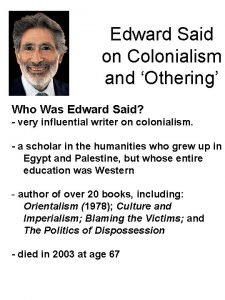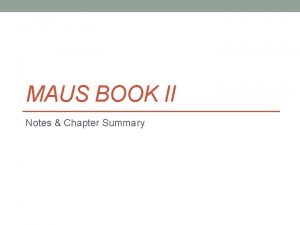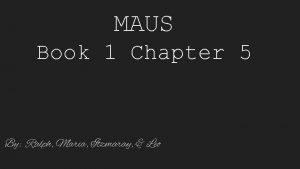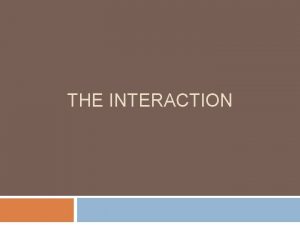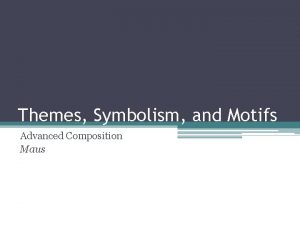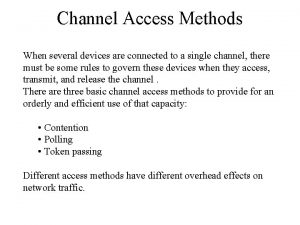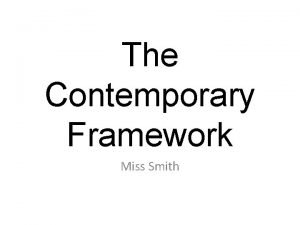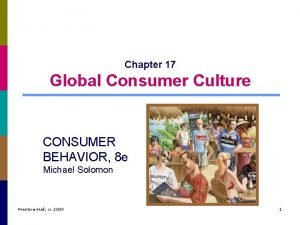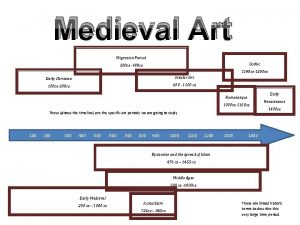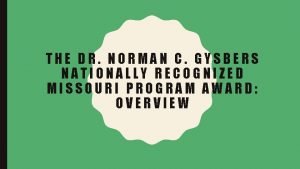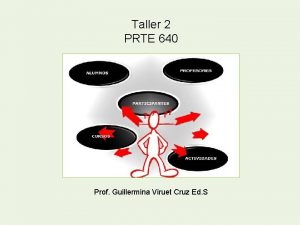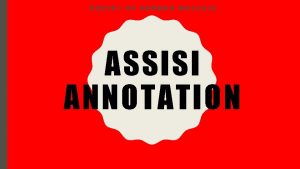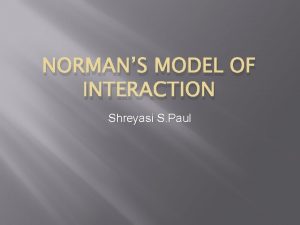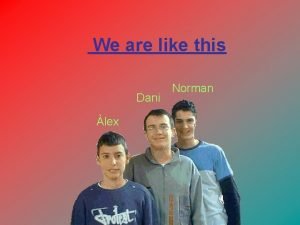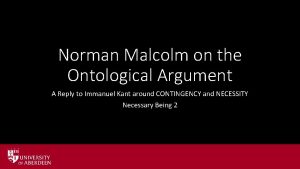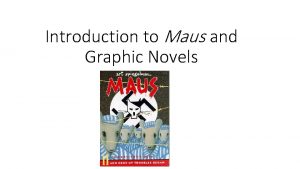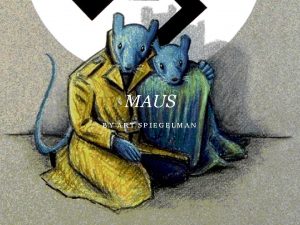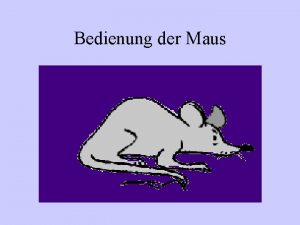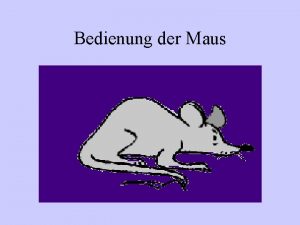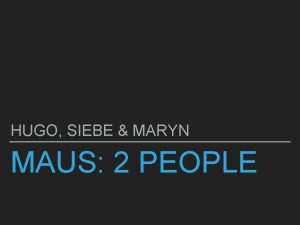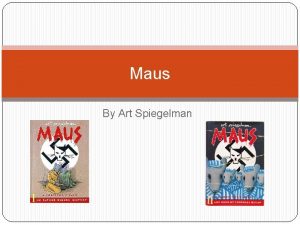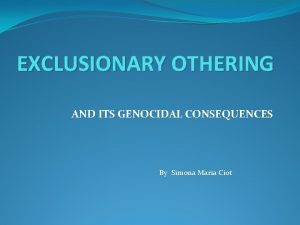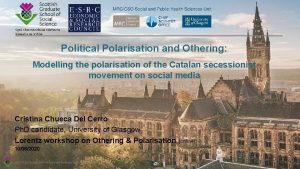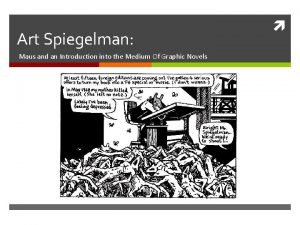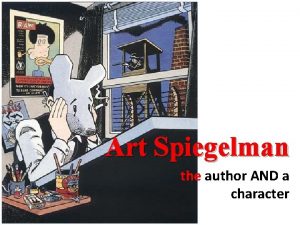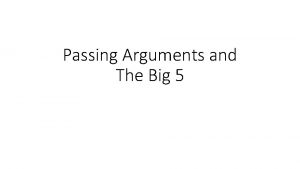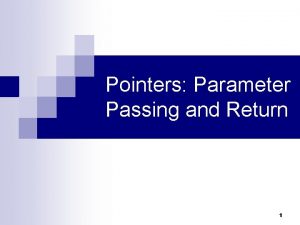Othering and Passing in Art Spiegelmans Maus Norman


































- Slides: 34

Othering and Passing in Art Spiegelman‘s Maus Norman Phung Van Julia Fischer Henriette Gert

What is Maus? Author: Art Spiegelman 2 Graphic Novels: 1978: Maus: A Survivors Tale, My Father Bleeds History 1986: Maus: A Survivors Tale, And Here My Troubles Began

Table of Content 1. 2. 3. 4. Hypothesis Animal Metaphors Spiegelman‘s Reason to Use Animals Means of Animal Metaphors 1. Othering 2. Passing 5. Struggles of Animal Metaphor 1. Loss of Identity 2. Perspective of Othering 6. Conclusion

Hypothesis By portraying individuals as different animal breeds, depending on their nationality or religion within the Holocaust, and especially by changing the means of depiction, Art Spiegelman shows that the strict thinking in constructed categories is too narrow to represent the complex varieties of individuals’ identities.

Groups Represented as Animals

Animal Breeds Represent. . . ? Groups vs. Character traits Races Nationalities → All Jews are depicted as → A brave Jew may be mice. depicted as a lion.

Mice Star of David Up to this point all polish Jews have been portrayed as mice

Mice Star of David Up to this point all polish Jews have been portrayed as mice Scared, nervous Hide before danger Vermin

Cats Swastika on the hat Up to this point Germans have been portrayed as cats

Cats Swastika on the hat Up to this point Germans have been portrayed as cats Hunter Tortures/Plays with victims

Pigs Up to this point polish christians have been portrayed as pigs

Pigs Up to this point polish christians have been portrayed as pigs Immoral behaviour (pigs in a moral sense) Eat everything they get served

Dogs, Frogs, Reindeers, Fish

Animal Breeds Are Used to Represent Different Groups Nice, „morally correct“ pigs Mice acting like Germans

Why Animals? • visible expression of oppression • anthropomorphic animals at the same screening • Cat-and-mouse metaphor

Means of Animal Metaphor

Othering • Nazi propaganda tries to other the jews (dehumanization) • amplification through simplification” (S. Mc. Cloud) • By identifying with mice in MAUS one becomes the other

Passing in Maus

Passing in Maus

Passing in Maus

Struggels of Animal Metaphor

Loss of Individuality

Simplification • Loss of individual identity –Restricted by categorical identity • Masks hide individual beings

Perspectives of Othering

Perspectives of Othering

Perspectives of Othering

Conclusion If an individual is assigned to a constructed category, a constructed “plus” of identity is put upon that individual; at the same time the individual loses individuality. The variety and complexity of individual’s identities is too complex to be depicted in constructed categories. Art Spiegelman exposes these limitations by the use and especially by the adaption of the categories of animal breeds.

Passing in Maus

Depiction of “real” Animals

Depiction of “real” Animals

Depiction of “real” Animals

Self-Reflexivity

Self-Reflexivity

Sources Primary Source Spiegelman, Art. The Complete Maus. London: Penguin, 2003. Print. Secondary Sources Kümmel, Peter. „Plötzlich sind wir alle Mäuse. “ Die Zeit. 40/2012 (2012): n. pag. Web. 08. 12. 2016. Sánchez, María Carla & Linda Schlossberg. Passing: Identity and Interpretation in Sexuality, Race, and Religion. New York: New York University Press, 2001. Print. Smith, Philip. Reading Art Spiegelman. London: Routledge, 2015. Print. Spiegelman, Art. Meta. MAUS. Fankfurt am Main: S. FISCHER Verlag, 2012. Print.
 Edward said othering
Edward said othering Maus part 2 chapter 1 summary
Maus part 2 chapter 1 summary Maus chapter 5 short summary
Maus chapter 5 short summary It is the translations between user and system?
It is the translations between user and system? Theme of maus
Theme of maus Themes in maus
Themes in maus Maus chapter 1 questions and answers
Maus chapter 1 questions and answers Passing beams
Passing beams Divergence measures and message passing
Divergence measures and message passing Token passing advantages and disadvantages
Token passing advantages and disadvantages Contemporary framework meaning
Contemporary framework meaning What is high art and low art
What is high art and low art Book of kells time period
Book of kells time period Norman gysbers
Norman gysbers Taxonomia webb
Taxonomia webb Norman webb taxonomy
Norman webb taxonomy Norman neureiter
Norman neureiter White cave of forgetfulness
White cave of forgetfulness Aunt julia norman maccaig analysis
Aunt julia norman maccaig analysis Assisi norman maccaig annotated
Assisi norman maccaig annotated Paco pacos
Paco pacos Did beatrix potter ever marry
Did beatrix potter ever marry Norman model of interaction
Norman model of interaction Claudia norman a marketing consultant
Claudia norman a marketing consultant Aunt julia bbc bitesize
Aunt julia bbc bitesize Chris norman biografia
Chris norman biografia Signing naturally homework 5:7
Signing naturally homework 5:7 What does norman ask melinda?
What does norman ask melinda? El reno path
El reno path Norman'ın körfez yaklaşımı
Norman'ın körfez yaklaşımı Norman ackerman
Norman ackerman Don norman affordances
Don norman affordances Don norman's design principles
Don norman's design principles Norman alex
Norman alex Norman malcolm ontological argument
Norman malcolm ontological argument
